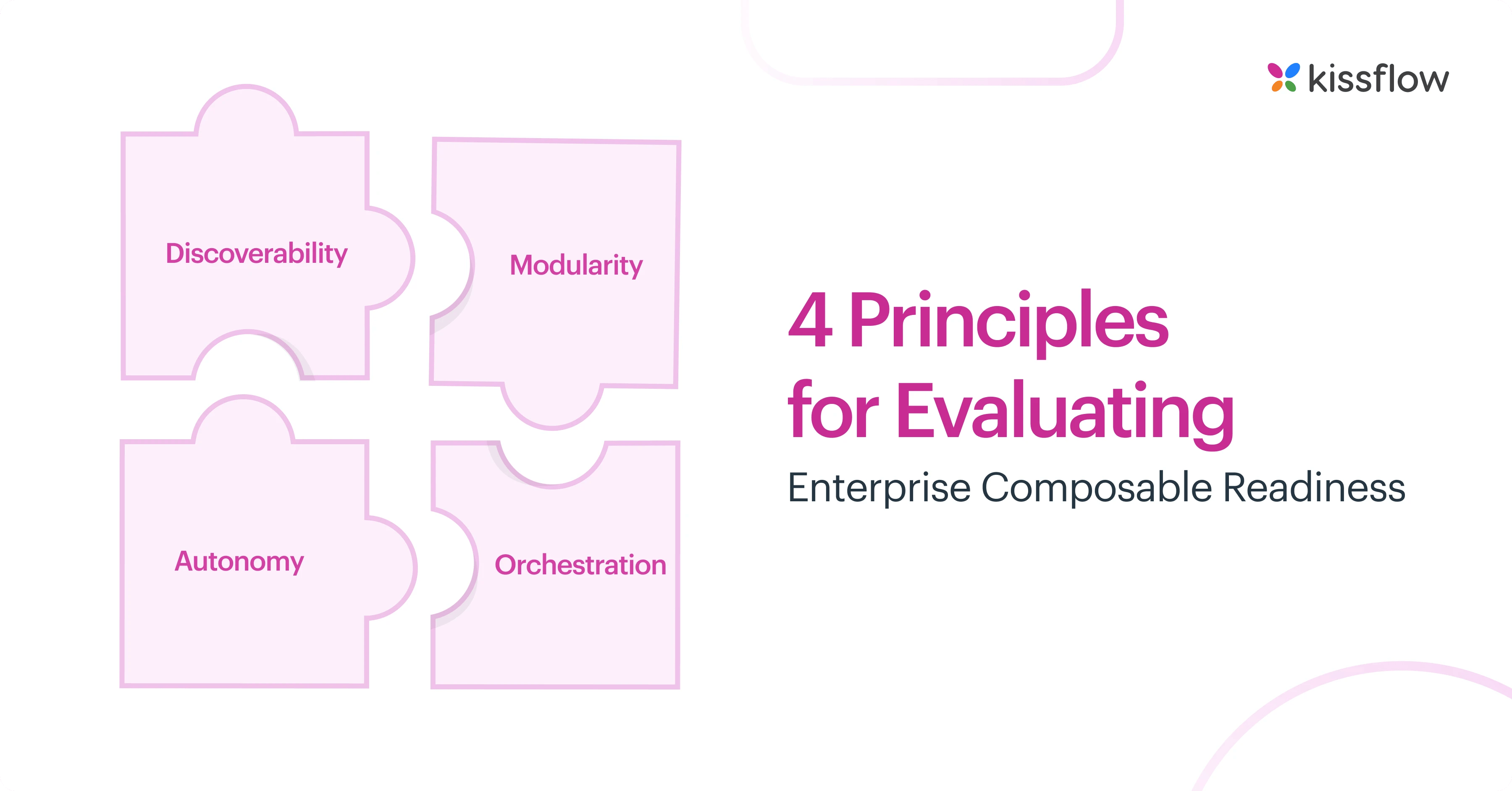
- >
- Application Development >
- Composable Applications – Everything You Need to Know
Composable Applications – Everything You Need to Know
Dynamic business and user demands combined with technological advancements have created a growing app development landscape. Moreover, vulnerability to rapid and unexpected changes has forced businesses to find ways to increase organizational flexibility and adaptability and continuously improve themselves to remain afloat and grow even under challenges.
Composable applications transform enterprise IT and help companies adapt to the digital environment by improving productivity, scalability, and streamlining business operation processes. They efficiently deliver quality-based reusable applications tools you can optimize and re-deploy quickly to meet customer expectations.

By 2028 the global composable infrastructure and applications market will reach $14.35 billion. The composability systems design approach increases agility and accelerates application development technologies, helping organizations reuse and re-assemble existing assets uniquely for improved data collection, use, and analysis and satisfy distinct user requirements.
Next-gen enterprise applications will be composable, scalable, with integrated speech and video capabilities, and powered by the latest technologies. If you’d like to maximize existing resources and meet diverse, constantly changing business demands, here’s everything you need to know about composable applications.
What are composable applications?
They’re a modern business-centric design approach to developing software with independent, interchangeable building blocks or modules. They’re built around application programming interfaces (APIs) and microservices, enabling app communication and increasing business efficiency.
Composable apps help organizations reuse interchangeable, functional pieces of code from existing applications and bundle them together, to build and modify existing applications or create larger, more complex apps with more features and utility.
Composable applications use modular, innovative, and adjustable solutions to repurpose functional individual processes or application pieces. With these detachable pieces, businesses can build more robust applications with improved functionality.
Benefits of adopting composable applications
Faster rollout of features
By updating existing app components rather than the entire app, composable apps enable developers to accelerate development than if they started building from scratch. Developers can launch features and updates faster by building and testing smaller, independent components rather than large, fossilized applications.
Composability provides a plug-and-play architecture that helps organizations pool resources, dismantle, swap, and re-assemble components quickly to match the fast-paced nature of business transformation.
Enhanced flexibility and agility
Composable apps help businesses become more innovative, resilient, and agile, so they can outpace their competition by up to 80 percent. Composable apps are easy to customize and reconfigure to meet ever-shifting customer needs and market changes. Organizations can adjust the size or capacity of these apps as needs arise without affecting their performance and reliability.
Businesses can swap out various composable applications to control app elements and change the functionality of their software system.
Improved efficiency
Pre-built components in composable apps can be easily combined, enabling businesses to develop custom applications more effortlessly. The apps’ modular design reuses code, so app development and maintenance require less time and effort, improving organizational efficiency.
Modular architecture helps businesses create, update or modify without disrupting the entire system, minimizing downtime and increasing efficiency. There are fewer code errors as standalone composable app components are extensively tested.
Reduced costs
By reusing existing composable app components, organizations can minimize the need for costly custom app developments and over-reliance on external third-party vendors. They also lower the expenses of hiring developers to build apps or maintaining a large IT team to rewrite existing code. Less skilled developers can also configure composable app components because there’s no need to understand the whole application.
Organizations can break down large applications into configurable puzzle pieces and plug pieces elsewhere to save time and money on development processes and timelines.

Choosing Your App Development Stack: A 11-Point Checklist
Thank you for reaching us!
Thank you for reaching us!
How do composable apps work?
Composable applications are practical, valuable building blocks for any business process. Their unique, separate pieces decrease the functional complexity of traditional development processes and help organizations develop new, more competent applications on-demand or improve the functionality of existing applications efficiently.
Composable applications' plug-and-play architecture enables organizations to pool resources and increase their innovation capabilities to become more flexible and resilient. With such applications, businesses can easily dismantle larger, more complex components and then adapt them to meet changing business requirements.
Since composable apps are loosely paired, they're easy to reuse and integrate seamlessly with multiple existing applications and systems. The composable architecture includes well-defined APIs that offer connectivity to independent components, making them composable and easily accessible over the cloud.
4 principles for evaluating enterprise composable readiness

Effective enterprise composability involves constructing and coordinating parts of an enterprise's apps, processes, and infrastructure to meet specific demands. To determine an organization's ability to meet complex digital business demands, use these four key principles:
1. Modularity
Organizations can achieve enterprise composability by adopting modularity as a core principle. Modularity breaks down complex IT infrastructure into smaller, more manageable, and reusable building blocks, easy to construct, dismantle, and re-assemble to create new applications.
With microservices and APIs, modularity improves application agility by packaging certain services into Packaged Business Capabilities (PCBs) ideal for a specific purpose.
2. Discoverability
Composable readiness enables various business components to work seamlessly regardless of the organization’s technology stack. In a composable business system, all team members should be able to find and reuse existing components to create new solutions.
A central record with sufficient descriptions and metadata to describe an application’s purpose and limitations significantly improves development speed.
3. Autonomy
Autonomous individual components heavily support enterprise composable readiness. Fully self-sufficient components independent of other system parts help developers detach from the complexity of legacy infrastructure, allowing them to focus on building applications faster.
This way, teams across the organization can update parts of the system without disrupting others, making apps far more resilient to changes.
4. Orchestration
Higher-order automation digitizes business processes and aligns workflow to match business goals and resources. Automation simplifies and streamlines the creation, testing, and deploying of software components, which minimizes the risk of errors and quickens the speed and reliability of app delivery.
Orchestration eliminates manual, time-consuming, and repetitious tasks, lowers costs, increases productivity, and helps businesses provide reliable service.
Building blocks of composable apps
- Composable thinking: It's behind the idea anything is composable. It fosters a responsive, more flexible way to design principles that guide organizations on what to compose and when to meet rapidly changing customer needs. Composable thinking encourages creativity and involves seeking and sharing information internally and externally.
- Composable business architecture: It includes capability, engagement, and technology. Each component has standardized APIs or interfaces to increase organizational flexibility and resilience, with unique business design mechanisms. Composable business architecture helps businesses develop a digital acceleration model to identify and implement changes capitalizing on digital transformation benefits.
- Composable technologies: They boost connectivity, reusability, and transparency across the organization. Adopting a robust tech foundation supports composability, which increases business agility and flexibility. The four principles of composable readiness act as product design goals to drive technology and promote composability, execution consistency, and faster response time
See how organizations improved efficiency in our case studies.
How leveraging low-code platforms helps build composable business apps better
Organizations are increasingly turning to low-code for highly customized automation to fulfill growing app demands and accelerate development. Low-code app development platform increase business agility, enabling businesses to change their composable apps and respond better to evolving business demands.
Low-code platforms are the perfect development platform for businesses to build composable apps. They have pre-built, functional components users can connect through a strong library of APIs to design apps. Additionally, with low-code, companies can build robust, easy-to-integrate applications through easy-to-use, drag-and-drop functionality with ready-made connectors and reusable templates.
Low-code platforms also create a collaborative ecosystem for IT and business teams to build composable apps which enhance communication, reduce errors, and guarantee effective apps. They streamline app development, allowing businesses to create and deploy better composable apps.
Since minimal to no-code is required, composable apps empower business teams to build apps that meet their needs without over-reliance on IT. low-code or no-code technology increases coordination and flexibility and eases IT workload.
Composable application - A real-world example
HP Enterprises
In 2019, HP Enterprises merged their HPE Synergy, HPE Primera Storage, and HPE composable rack to support application composability and enhance application's flexibility and service level agility. HPE's innovative, composable infrastructure solutions are built on a new intelligent approach that creates value, runs traditional workloads efficiently, and powers new cloud-based applications across a hybrid cloud infrastructure.
HPE's intelligent composable infrastructure allows organizations to manage computing, networking, and storage resources through a web-based interface. It enables users to modernize and accelerate IT operations, innovate, and build apps in a modern, agile environment. HPE uses a single intelligent infrastructure to eliminate costly silos and manage hybrid workloads with fluid resource pools.
Role of composable applications in digital transformation
Composable applications help businesses leverage modularity and create opportunities to alleviate increased change-related risks. They help organizations capitalize on market possibilities and pivot quickly enough to encourage digital transformation. They eliminate reliance on a single system and have fewer system threats, which boosts security and prevents business disruptions.
Composable architecture with advanced data integration reduces development complexity helping employees operate more effectively. Technology democratization helps organizations distribute responsibilities accurately between business-IT teams and divert application modularity to business capabilities, increasing company competitiveness.
Digital transformation helps organizations refine core capabilities, use a custom approach to develop apps and tailor them to specific business requirements. Composable apps offer unprecedented developer productivity and enterprise efficiency, allowing users to build new apps from existing code or apps and incorporate them readily into existing technological stacks.
Composable apps enable businesses to adopt a dynamic environment that responds instantly to customer needs. The apps' autonomous, self-governing systems keep businesses running because if one system fails, it can be quickly corrected without impacting the rest.
The future of enterprise app development is composable
In the face of new technologies, businesses must architect real-time resilience and adaptability with composable apps. Here's why composable apps are here to stay.
- By 2024 60 percent of finance organizations will be looking to invest in composable finance applications as part of their new technology investments.
- By 2025, 70 percent of new enterprise applications will be developed using low-code or no-code technologies.
- The composable infrastructure and applications market is expanding rapidly and is expected to reach USD 3.3 billion by 2026.
- By the end of 2028, the composable infrastructure and applications market is expected to grow to $14.35 billion.
- By 2030 the growth of composable applications is projected to rise significantly to $95.98 billion.
Handle future volatility with composable applications
Companies undertaking digital transformation need composable apps to prepare for the challenges and stay ahead of the curve. These apps offer diverse benefits, and businesses can instantly deploy innovative apps aligning with specific business goals. Properly implemented, composable applications enable businesses to reduce go-to-market time and build improved applications with better functionality.
Kissflow’s unified application development platform offers a modern, user-friendly interface, pre-built connectors, drag-and-drop tools, and templates to streamline composable application development and management.
Transform your business into a flexible, intelligent composable enterprise with Kissflow and build apps with smart features to meet changing organizational needs.
Discover how the Kissflow Low-Code App Development platform can streamline your development process.
FAQs
1. What are composable applications in an enterprise context?
Composable applications are built from modular, interchangeable building blocks—such as services, workflows, and UI elements—that can be assembled and reassembled to support different scenarios. This approach makes applications more flexible, maintainable, and adaptable to change.
2. How do composable apps help CIOs respond to changing business needs?
Instead of rebuilding whole systems, teams can recombine existing components to support new products, processes, or channels. This dramatically shortens the time it takes to adjust to new requirements.
3. How does low-code support composable application design?
Low-code platforms often provide component libraries, reusable workflows, and visual composition tools. This makes it easier to create, manage, and reuse modules across multiple applications without deep coding.
4. What governance is needed for composable applications?
Clear ownership, naming standards, versioning, and approval workflows are critical to prevent fragmentation. Governance ensures that components are trustworthy and safe to reuse across the organization.
5. How do composable applications reduce technical debt?
When functionality is encapsulated in reusable components, updates happen in one place instead of many. This centralization prevents duplicated logic and makes it easier to keep applications aligned with evolving requirements.
6. How do composable apps influence integration strategy?
They encourage standardized, API-driven integration patterns so components can be connected consistently, reducing custom integration work.
Start building your own apps with Kissflow
"The application is very dynamic and useful in all our business cases and the platform is very user-friendly and implementation was great."
Thanks for submitting.
Our solution experts will connect with you to get started.
Related Articles











